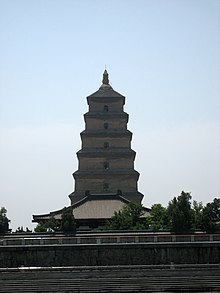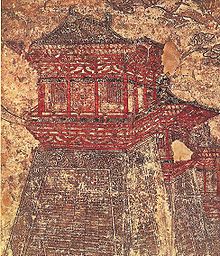Chang'an
![]()
The title of this article is ambiguous. For other meanings, see Chang'an (disambiguation).
34.2666666667108.9Coordinates: 34° 16′ N, 108° 54′ E
Chang'an (Chinese 長安 / 长安, pinyin![]() , W.-G. Ch'ang-an) was a city of Chinese antiquity. It was originally located five kilometers northwest of modern Xi'an, but was relocated and refounded several times. Chang'an served as the capital of the Western Han Dynasty as well as the Xin, Sui, and Tang Dynasties. Its name was eventually changed to Xi'an under the Ming Dynasty.
, W.-G. Ch'ang-an) was a city of Chinese antiquity. It was originally located five kilometers northwest of modern Xi'an, but was relocated and refounded several times. Chang'an served as the capital of the Western Han Dynasty as well as the Xin, Sui, and Tang Dynasties. Its name was eventually changed to Xi'an under the Ming Dynasty.
History
Chang'an was first mentioned during the Spring and Autumn Annals (722-481 BC) and had a population of over 33,000 around 650 BC. The first historical emperor of unified China, Qin Shihuangdi († 210 BC), built his mausoleum near the city, which was discovered in 1974 with the famous terracotta army. Xianyang, the capital of the Qin, was also located not far from present-day Xi'an.
Chang'an, which served as the capital of the Western Han Dynasty (206 BC to AD 9), was a world city by the standards of the time. The city had a population of about 120,000 during the reign of the first Han emperor Gaozu. The construction of the imperial capital of Chang'an is divided into three periods, which together lasted more than 90 years. Emperor Gaozu had the imperial palace built outside the city. In 202 BC, he had the Xingle Palace (兴乐宫) of the Qin Dynasty renovated and renamed it the Changle Palace (长乐宫). In 200, the emperor built the Eternal Palace (未央宫) seven kilometers northeast of present-day Xi'an, where the government resided from then on. After the death of Emperor Gaozu (195 BC), his successor Hui built the Chang'an city fortifications, which were completed in September 191 and covered an area of 36 sq km. He and his later successor Emperor Wu gave the city many more palace buildings. In the 1st century BC, Chang'an reached a population of 250,000.
After the legation of the imperial official Zhang Qian, during which he traveled through Central Asia and the Near East, Chang'an became China's "gateway to the world" as a port of call on the newly emerging Silk Road. However, the decline of the Han Dynasty also ended the city's prosperity. By 2 AD, when the empire was already completely controlled by the official Wang Mang (who founded the short-lived Xin Dynasty in 9 AD), the population had already plummeted. Its destruction during the Civil War (until 23 AD) sealed its fate. It was still chosen as capital by Emperor Gengshi, but after his death (25 AD) his successor Guangwu decided to make the prosperous Luoyang the capital. His dynasty is therefore called the Eastern Han Dynasty. Chang'an, which now bore the name Western Capital, sank into insignificance and had only 81,000 inhabitants around the year 100.
In the civil war following the collapse of the Eastern Han Dynasty (184-220), the usurper Dong Zhuo decided to move the government from Luoyang to Chang'an, as the city was easier to defend in the shadow of the mountains. After his death (192) and the decline of his successors (195), the young Emperor Xian left the city and headed for the completely destroyed Luoyang, where he was welcomed and taken in by the warlord Cao Cao.
Under the Sui dynasty, Chang'an once again became the capital. Emperor Wen chose a site south of Chang'an for his new palace in 582 AD, which he named Daxing. In 589, he unified China, which had been divided since 313. Chang'an had 95,000 inhabitants at that time.
The Sui dynasty was followed in 618 by the Tang dynasty, which took over the capital from its predecessors. With 1,000,000 inhabitants in the 8th century, the city was the largest in the world at that time. Its layout was the model for the capitals of Japan in antiquity (Fujiwara-kyō, Heijō-kyō, Heian-kyō) and Gyeongju in Silla (Korea). The city's Ximing Temple was a focal point for pilgrims from all over the world. Here, Indian pilgrims translated their sutras into Chinese. The Japanese founder of Shingon Buddhism Kūkai stayed here around 805 and studied Sanskrit. After the Battle of Talas in 751, in which the Abbasids were able to weaken Chinese influence in Central Asia, Arab traders arrived in the city.
At the end of the 8th century - beginning with the An Lushan Rebellion, Chang'an was occupied and destroyed several times by rebels. By 900, Chang'an had a population of only 500,000. After the Tang Dynasty, the former imperial capital fell into insignificance. Under the Ming Dynasty, the provincial city of Chang'an, whose area within the massive city walls was only 12 km², was renamed Xi'an.
The site of the Han-era capital Chang'an and the site of the Daxing Palace of the Sui Dynasty in Tang-era Chang'an are on the list of monuments of the People's Republic of China.

Great Wild Goose Pagoda of Chang'an, built 652

City gate of Tang-period Chang'an, painting from the tomb of Prince Li Chongrun
Environment
Chang'an City includes the Daming Palace to the east, which long represented Tang power and culture with magnificence, grandeur and sophistication; Taiji Palace to the west; and Xingqing Palace to the south.
Questions and Answers
Q: What was Chang'an?
A: Chang'an was the capital of ancient China for more than ten dynasties in Chinese history.
Q: What does the name Chang'an mean in Classical Chinese?
A: The name Chang'an literally means "Perpetual Peace" in Classical Chinese.
Q: What happened to the name of the city during the Xin Dynasty?
A: During the Xin Dynasty, the name of the city was changed to "Constant Peace".
Q: What happened to the name of the city after the fall of the Xin Dynasty in 23 AD?
A: After the fall of the Xin Dynasty in 23 AD, the old name of the city, Chang'an, was restored.
Q: When was the name of the city changed to its present name, Xi'an?
A: The name of the city was changed to its present name, Xi'an, during the Ming Dynasty.
Q: What does the name Xi'an mean?
A: The name Xi'an means "Western Peace".
Q: How many dynasties in Chinese history had Chang'an as their capital?
A: Chang'an was the capital of ancient China for more than ten dynasties in Chinese history.
Search within the encyclopedia